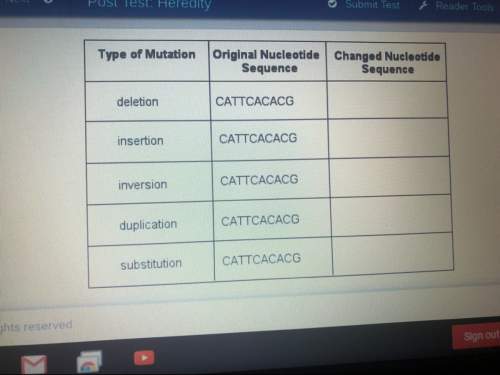
Biology, 18.02.2020 17:56 live4dramaoy0yf9
According to your data, was your hypothesis correct? (Be sure to refer to your data when answering this question.)
Summarize any difficulties or problems you had in performing the experiment that might have affected the results. Describe how you might change the procedure to avoid these problems.
So let’s measure the mass of 5 of each type of coin and find the average. [A stack of five pennies on the scale. Five nickels to the left of the scale, five quarters to the right of the scale]
The mass of 5 pennies is 12.5g. [Electronic balance scale massing five pennies with a reading of 12.5]
To calculate the mass of one penny, divide 12.5g by the number of pennies, 5. [mass 12.5 divided by 5]
So the average mass of one penny is 2.5g.
Let’s find the average mass of a nickel and a quarter
The mass of 5 nickels is 25g. [Five nickels are stacked on the scale with a reading of 25.0]
The mass of 5 quarters is 28.4g. [Five quarters are stacked on the scale with a reading of 28.4]
Find the average mass of each type of coin. [Nickel mass 25 divided by 5] [Quarter mass 28.4 divided by 5]
Now let’s find the volume of each.
Let’s use the water displacement method. [Graduated cylinder]
Again, it will be easier to use a number of each type of coin and find the average. [A stack of 20 pennies, 20 nickels, and 20 quarters appear]
We’ll use 20 of each type of coin. [coins times 20]
To find the volume of 20 pennies, we will add water to the graduated cylinder, record the volume, add 20 pennies and record the increase in volume. [Water is added to the 50 mL line of the graduated cylinder and 20 pennies are placed in it]. [57.2 mL]
Subtract the volume of the water from the volume of the water and pennies.
This is the volume of 20 pennies, so divide that volume by 20 to find the average volume of a single penny. [20 pennies = 7.2][ 20 pennies = 7.2 divided by 20. One penny = .36 mL]
The average volume of one penny, rounded to the nearest milliliter is 0.40. [One penny = .4 mL]
Let’s do the same thing with the nickels and quarters.
The volume of 20 nickels plus 50.0 ml of water is 64.4ml. [Graduated cylinder with 50 mL of water and 20 nickels. Nickel times 20 = 67.4 mL]
Calculate the volume of one nickel. [Nickel = 64.4 mL divided by 20]
The volume of 20 quarters plus 50.0 ml of water is 66.2ml. [Graduated cylinder with 50 mL of water and quarters] [Quarter times 20 = 66.2 mL]
Calculate the volume of one quarter. [Quarter = 66.2 mL divided by 20]
List at least two real-world examples that apply the findings of this experiment. (Hint: An example of this type was given in the introduction to this project.)

Answers: 2


Other questions on the subject: Biology

Biology, 22.06.2019 11:10, allisonpierce1787
Which of these statements is true about autotrophs, but not heterotrophs? a. they use sugar and oxygen to make carbon dioxide and water. b. they use chlorophyll and oxygen to make carbon dioxide and water. c. they use sunlight, water, and carbon dioxide to make sugars. d. they use sunlight, water, and oxygen to make chlorophyll.
Answers: 1

Biology, 22.06.2019 11:20, gamallopatty
Archeologists have discovered three sites showing conclusive evidence for the mastery of fire in tanzania, from a period slightly after the time that homo habilis was present in africa. these sites clearly were founded by homo erectus, the descendent species of homo habilis that migrated north, out of africa and into asia. homo erectus was known to have mastered fire, from ample evidence at sites in asia. there is no reason to attribute mastery of fire to homo ergaster, the descendent species of homo habilis that remained in africa. which of the following is an assumption on which the argument depends? (a) before their migration, homo erectus occupied african territory as far south as tanzania.(b) the strain of migration provided the selective pressure motivating homo erectus‘ mastery of fire.(c) homo ergaster would not have derived as much benefit from the mastery of fire as did homo erectus.(d) homo ergaster inherited all cultural knowledge from homo habilis, a species that did not have mastery of fire.(e) homo ergaster did not occupy regions as far south as tanzania until well after the time of these three sites.
Answers: 2

Biology, 22.06.2019 14:20, audrey1256
Do the following statements describe actin, myosin, both of the proteins or neither of the proteins? (a) contains a binding site for calcium (b) found in the i band (c) exists in a globular (g) form and a filamentous (f) form (d) contains a binding site for atp (e) is a component of the thin filament (f) is a component of the thick filament
Answers: 2

Biology, 22.06.2019 15:30, goodluck99
Ascientist is designing an investigation to study the impact of invasive bird populations on local, native bird populations at backyard bird feeders. what population is most likely to be a control group for the investigation? amount of food number of bird feeders invasive bird populations local backyard birdfeeders without food
Answers: 1
You know the right answer?
According to your data, was your hypothesis correct? (Be sure to refer to your data when answering t...
Questions in other subjects:

Physics, 03.09.2021 22:10


English, 03.09.2021 22:10

Mathematics, 03.09.2021 22:10




Social Studies, 03.09.2021 22:10

Mathematics, 03.09.2021 22:10

Mathematics, 03.09.2021 22:10




